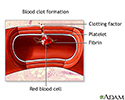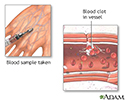Factor X deficiency
Stuart-Prower deficiency
Factor X (ten) deficiency is a disorder caused by a lack of a protein called factor X in the blood. It leads to problems with blood clotting (coagulation).
Causes
When you bleed, a series of reactions take place in the body that helps blood clots form. This process is called the coagulation cascade. It involves special proteins called coagulation, or clotting, factors. You may have a higher chance of excess bleeding if one or more of these factors are missing or are not functioning like they should.
Factor X is one such coagulation factor. Factor X deficiency is often caused by an inherited defect in the factor X gene. This is called inherited factor X deficiency. Bleeding ranges from mild to severe depending on how severe the deficiency is.
Factor X deficiency can also be due to another condition or use of certain medicines. This is called acquired factor X deficiency. Acquired factor X deficiency is common. It can be caused by:
- Lack of vitamin K (some newborns are born with vitamin K deficiency)
-
Buildup of abnormal proteins in the tissues and organs (
amyloidosis
)
Amyloidosis
Secondary systemic amyloidosis is a disorder in which abnormal proteins build up in tissues and organs. Clumps of the abnormal proteins are called a...
 ImageRead Article Now Book Mark Article
ImageRead Article Now Book Mark Article - Severe liver disease
- Use of medicines that prevent clotting (anticoagulants such as warfarin)
Women with factor X deficiency may first be diagnosed when they have very heavy menstrual bleeding and bleeding after childbirth. The condition may be first noticed in newborn boys if they have bleeding that lasts longer than normal after circumcision.
Symptoms
Symptoms may include any of the following:
- Bleeding into the joints
- Bleeding into the muscles
- Bruising easily
- Heavy menstrual bleeding
-
Mucus membrane
bleeding
Mucus membrane
Mucosa is moist tissue that lines certain parts of the inside of your body. It is in your: NoseMouthLungsUrinary and digestive tracts Glands in this...
 ImageRead Article Now Book Mark Article
ImageRead Article Now Book Mark Article - Nosebleeds that do not stop easily
- Umbilical cord bleeding after birth
Exams and Tests
Tests that may be done include:
-
Low
factor X activity
Factor X activity
The factor X assay is a blood test to measure the activity of factor X. This is one of the proteins in the body that helps the blood clot.
Read Article Now Book Mark Article - Normal thrombin time
-
Prolonged
partial thromboplastin time
(PTT)
Partial thromboplastin time
Partial thromboplastin time (PTT) is a blood test that looks at how long it takes for blood to clot. It can help tell if you have a bleeding problem...
Read Article Now Book Mark Article -
Prolonged prothrombin time
(PT)
Prolonged prothrombin time
Prothrombin time (PT) is a blood test that measures the time it takes for the liquid portion (plasma) of your blood to clot. A related blood test is ...
Read Article Now Book Mark Article
Treatment
Bleeding can be controlled by getting intravenous (IV) infusions of plasma or concentrates of clotting factors. If you lack vitamin K, you can take vitamin K by mouth, through injections under the skin, or through a vein (intravenously).
If you have this bleeding disorder, be sure to:
- Tell your health care providers before you have any kind of procedure, including surgery and dental work.
- Tell your family members because they may have the same disorder but do not know it yet.
Support Groups
Find out more about bleeding disorders through these groups:
American Society of Hematology -- www.hematology.org/Patients/Blood-Disorders.aspx
National Hemophilia Foundation: Other Factor Deficiencies -- www.hemophilia.org/Bleeding-Disorders/Types-of-Bleeding-Disorders/Other-Factor-Deficiencies
Victory for Women with Blood Disorders -- www.hemophilia.org/Community-Resources/Women-with-Bleeding-Disorders/Victory-for-Women-with-Blood-Disorders
Outlook (Prognosis)
The outcome is good if the condition is mild or you get treatment.
Inherited factor X deficiency is a lifelong condition.
The outlook for acquired factor X deficiency depends on the cause. If it is caused by liver disease, the outcome depends on how well your liver disease can be treated. Taking vitamin K supplements will treat vitamin K deficiency. If the disorder is caused by amyloidosis, there are several treatment options. Your doctor can tell you more.
Possible Complications
Severe bleeding or sudden loss of blood (hemorrhage) can occur. The joints may get deformed in severe disease from many bleeds.
Bleeding
Bleeding is the loss of blood. Bleeding may be:Inside the body (internally) Outside the body (externally)Bleeding may occur:Inside the body when blo...

When to Contact a Medical Professional
Get emergency medical help if you have an unexplained or severe loss of blood.
Prevention
There is no known prevention for inherited factor X deficiency. When a lack of vitamin K is the cause, using vitamin K can help.
References
Gailani D, Neff AT. Rare coagulation factor deficiencies In: Hoffman R, Benz EJ Jr, Silberstein LE, Heslop HE, Weitz JI, Anastasi JI, eds. Hematology: Basic Principles and Practice . 6th ed. Philadelphia, PA: Elsevier Saunders; 2012:chap 139.
Ragni MV. Hemorrhagic disorders: coagulation factor deficiencies. In: Goldman L, Schafer AI, eds. Goldman's Cecil Medicine . 24th ed. Philadelphia, PA: Elsevier Saunders; 2012:chap 177.
-
Blood clot formation - illustration
Blood clotting normally occurs when there is damage to a blood vessel. Platelets immediately begin to adhere to the cut edges of the vessel and release chemicals to attract even more platelets. A platelet plug is formed, and the external bleeding stops. Next, small molecules, called clotting factors, cause strands of blood-borne materials, called fibrin, to stick together and seal the inside of the wound. Eventually, the cut blood vessel heals and the blood clot dissolves after a few days.
Blood clot formation
illustration
-
Blood clots - illustration
Blood clots (fibrin clots) are the clumps that result when blood coagulates.
Blood clots
illustration
-
Blood clot formation - illustration
Blood clotting normally occurs when there is damage to a blood vessel. Platelets immediately begin to adhere to the cut edges of the vessel and release chemicals to attract even more platelets. A platelet plug is formed, and the external bleeding stops. Next, small molecules, called clotting factors, cause strands of blood-borne materials, called fibrin, to stick together and seal the inside of the wound. Eventually, the cut blood vessel heals and the blood clot dissolves after a few days.
Blood clot formation
illustration
-
Blood clots - illustration
Blood clots (fibrin clots) are the clumps that result when blood coagulates.
Blood clots
illustration
Review Date: 1/22/2015
Reviewed By: Rita Nanda, MD, Assistant Professor of Medicine, Section of Hematology/Oncology, University of Chicago Medicine, Chicago, IL. Review provided by VeriMed Healthcare Network. Also reviewed by David Zieve, MD, MHA, Isla Ogilvie, PhD, and the A.D.A.M. Editorial team.


